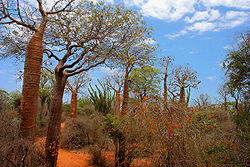
Madagascar spiny thickets
Encyclopedia

Ecoregion
An ecoregion , sometimes called a bioregion, is an ecologically and geographically defined area that is smaller than an ecozone and larger than an ecosystem. Ecoregions cover relatively large areas of land or water, and contain characteristic, geographically distinct assemblages of natural...
in Madagascar
Madagascar
The Republic of Madagascar is an island country located in the Indian Ocean off the southeastern coast of Africa...
. The vegetation type is found on poor substrates with low, erratic winter rainfall. An estimated 14,000 to 17000 square miles (44,029.8 km²) is covered with this habitat, all in the southwest of the country. The ecoregion contains an outstanding proportion of endemic plant species.
Plant diversity

Didiereaceae
Didiereaceae is a small family of just four genera and 11 species of flowering plants endemic to south and southwest Madagascar, where they form an important component of the Madagascar spiny forests.-Description:...
form a conspicuous component, especially towards the east. They are woody but distantly related to the Cacti
Cactus
A cactus is a member of the plant family Cactaceae. Their distinctive appearance is a result of adaptations to conserve water in dry and/or hot environments. In most species, the stem has evolved to become photosynthetic and succulent, while the leaves have evolved into spines...
(See Caryophyllales
Caryophyllales
Caryophyllales is an order of flowering plants that includes the cacti, carnations, amaranths, ice plants, and many carnivorous plants. Many members are succulent, having fleshy stems or leaves.-Description:...
). The remaining component of the thickets is dominated by members of the Burseraceae
Burseraceae
Burseraceae is a moderate-sized family of 17-18 genera and about 540 species of flowering plants. The actual numbers differ according to the time period in which a given source is written describing this family. The Burseraceae is also known as the Torchwood family, the frankincense and myrrh...
, Euphorbiaceae
Euphorbiaceae
Euphorbiaceae, the Spurge family are a large family of flowering plants with 300 genera and around 7,500 species. Most are herbs, but some, especially in the tropics, are also shrubs or trees. Some are succulent and resemble cacti....
, Anacardiaceae
Anacardiaceae
Anacardiaceae are a family of flowering plants bearing fruits that are drupes and in some cases producing urushiol, an irritant. Anacardiaceae include numerous genera with several of economic importance. Notable plants in this family include cashew , mango, poison ivy, sumac, smoke tree, and marula...
and Fabaceae
Fabaceae
The Fabaceae or Leguminosae, commonly known as the legume, pea, or bean family, is a large and economically important family of flowering plants. The group is the third largest land plant family, behind only the Orchidaceae and Asteraceae, with 730 genera and over 19,400 species...
families of plants, all which have representatives elsewhere.
Conservation
Existing reserves protect a maximum of 3% of remaining vegetation. The Andohahela National ParkAndohahela National Park
Andohahela National Park, in southeast Madagascar, is remarkable for the extremes of habitats that are representened within it. The park covers 760 square kilometers of the Anosy mountain range, the southernmost spur of the Malagasy Highlands...
offers limited protection through its 'parcel 3' section. Elsewhere the spiny thicket habitat is under pressure from human exploitation. The main impacting activities are:
- Burning for conversion to grazing land
- Harvesting for charcoal and firewood
- Logging for construction
See also
- Berenty ReserveBerenty ReserveBerenty Reserve is a small private reserve of gallery forest along the Mandrake river, set in the semi-arid spiny forest ecoregion of the far south of Madagascar. For more than three decades the primatologist Alison Jolly , researchers and students have visited Berenty to conduct fieldwork on lemurs...
- Beza Mahafaly ReserveBeza Mahafaly ReserveThe Beza Mahafaly Reserve is a nature reserve in Madagascar located northeast of Betioky Sud. The Reserve also provides training and research opportunities. It consists of a fenced gallery forest, approximately , separated by from a gallery of arid spiny forest...
- Ebenavia maintimaintyEbenavia maintimaintyEbenavia maintimainty is a small nocturnal gecko species of the genus Ebenavia that is native to Madagascar. It is found in a small area of limestone cliffs to the east of Lake Tsimanampetsotsa on the Mahafaly Plateau. This habitat forms part of the Madagascar spiny thickets ecoregion.-External...
- Ecoregions of MadagascarEcoregions of MadagascarMadagascar island, located in the Indian Ocean off the east coast of Africa, is the fourth largest island in the world. Its long isolation from neighbouring continents allowed the evolution of distinct communities of plants and animals. It is home to five percent of the world's plant and animal...
- Lake TsimanampetsotsaLake TsimanampetsotsaLake Tsimanampetsotsa is a saline lake in the Toliara Province, southwestern part of Madagascar. It is located at around . The lake is an important wetland and it is protected within a national park and as a Ramsar site. Ramsar site has a total area of 456.00 km² while the surface of the lake is...
- List of national parks of Madagascar
- Moringa genusMoringaMoringa is the sole genus in the flowering plant family Moringaceae. The name is derived from the Tamil word murunggai or the Malayalam word muringa, both of which refer to M. oleifera...
- SakoaSakoaSakoa is a region of southwestern Madagascar characterised by dry spiny forest and known particularly for its coal fields, the highest quality of which is the Sakoa field. There are a number of license holders on the field...

